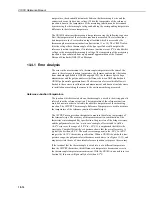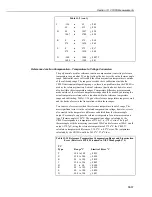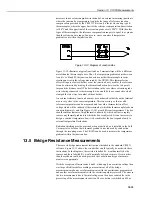
CR10X Reference Manual
13-4
It is obviously best to use differential measurement thermocouples in these
circumstances, if possible, to guarantee accurate measurements.
However, if single-ended thermocouples have to be used for critical
measurements and the permanently powered sensors generate a large enough
signal (so that the measurement differences between AG and G is minimal) you
can use the G terminal for the continuously powered sensors and so reduce errors
in the thermocouple readings.
13.3 The Effect of Sensor Lead Length on Signal
Settling Time
Whenever an analogue input is switched into the CR10X measurement circuitry
before making a measurement, a finite amount of time is required for the signal to
stabilise at its correct value. The rate at which the signal settles is determined by
the input settling time constant, which is a function of both the source resistance
and the input capacitance (explained below). The CR10X allows a 450µs settling
time before initiating the measurement. In most applications this settling time is
adequate, but the additional wire capacitance associated with long sensor leads
can increase the settling time constant to the point that measurement errors may
occur. There are three potential sources of error which must settle before the
measurement is made:
1.
The signal must rise to its correct value.
2.
A small transient (
≅
5mV) caused by switching the analogue input into the
measurement circuitry must settle.
3.
A larger transient, usually about 40mV/V, caused by the switched, precision
excitation voltage used in resistive bridge measurements, must settle.
The purpose of this section is to bring attention to potential measurement errors
caused when the input settling time constant gets too large and to discuss proce-
dures whereby the effects of lead length on the measurement can be estimated. In
addition, physical values are given for three types of wire used in Campbell
Scientific sensors, and error estimates for given lead lengths are provided. Finally,
techniques are discussed for minimising input settling error when long leads are
unavoidable.
13.3.1 The Input Settling Time Constant
The rate at which an input voltage rises to its full value or at which a transient
decays to the correct input level are both determined by the input settling time
constant. In both cases the waveform is an exponential. Figure 13-4 shows both a
rising and decaying waveform settling to the signal level, V
so
. The rising input
voltage is described by Equation 1 and the decaying input voltage by Equation 2.
Figure 13-4 Input Voltage Rise and Transient Decay
















































